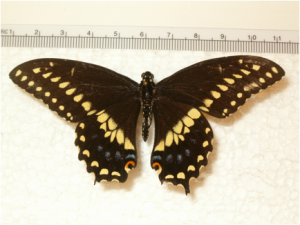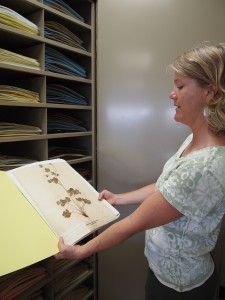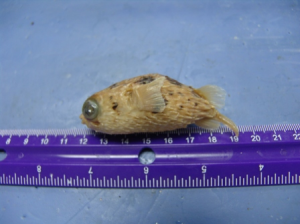Are you a Planet Earth fanatic? If so, check out Gustavus’ biology collections. The Biology Department at Gustavus Adolphus College curates diverse collections of organisms including plants, vertebrate animals and invertebrate animals, including both the very beautiful and the very bizarre. For those who prefer the beautiful, a large collection of butterflies can be viewed online, complete with photos, on the Gustavus department of biology webpage (https://gustavus.edu/biology/projects/bugs/index.html). The familiar Black Swallowtail butterfly (Papilio polyxenes), with its characteristic black wings and sapphire blue spots, can be found in the collections, along with more exotic species, such as the Red Postman (Heliconius erato), a butterfly native to South America.

The Black Swallowtail is one of many insect species made viewable online by Gustavus biology students.
The herbarium constantly expands due to new additions from the plant biology course offered at Gustavus. Students learn how to identify different species, and what constitutes a “good” specimen. Pamela Kittelson, professor of biology, explained that a good specimen shows multiple aspects of the plant, such as flowers, fruits, leaves, and roots. Students have the opportunity to take field trips to collect specimens from southern Minnesota, Montana, and the southeastern United States, which allows scientists to compare samples, and see if there are regional differences between specimens. The oldest specimen in the herbarium collection is 130 years old, dating back to 1881.
The fish collection, complete with both live and preserved freshwater and marine fish, contains both beautiful and bizarre species. The live aquarium holds the fish made famous by the Pixar movie Finding Nemo, the Orange Clownfish (Amphiprion percula), along with a colorful array of anemones. Less visually appealing, but just as interesting species in the collection include the aptly named Oyster Toadfish (Opsanus tau) and the Long Spine Porcupine Fish (Diodon holocanthus). For those interested in learning more, students have the opportunity to explore, enhance, and catalogue the collections through the Rupert Anderson Award in Systematics. For instance, the efforts of students Josh Hammer and Carl Stenoien resulted in the online catalogue available on the Gustavus department of biology webpage.
Students may also learn more by taking courses that utilize the collections, such as Plant Systematics, Aquatic Biology, Vertebrate Biology, and Invertebrate Zoology.

